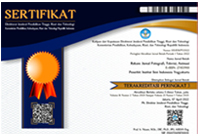Efektivitas Video Youtube “Mengubah Sampah Plastik Menjadi Sumber Daya Energi Berkelanjutan” Menggunakan Model Epic
Abstract
ABSTRAK
Indonesia merupakan negara penyumbang sampah plastik terbesar kedua di dunia dengan total sampah yang tidak terkelola dengan baik mencapai 3,22 juta ton per tahunnya. Hal ini tentu berdampak signifikan terhadap kerusakan lingkungan. Melalui penelitian ini digagaslah sebuah video yang bertujuan menginformasikan kepada masyarakat tentang permasalahan sampah yang ada di lingkungan sekitar dan bagaimana pengelolaan sampah yang sejauh ini sudah dilakukan di Indonesia. Melalui publikasi via Youtube, dilakukanlah analisis dengan menggunakan model EPIC yang dikembangkan oleh AC Nielsen untuk mengukur efektivitas video dalam mempengaruhi keputusan audiens dalam menyikapi penggunaan teknologi yang membantu dalam pengelolaan sampah plastik. Penelitian kuantitatif ini melibatkan 100 masyarakat Kota Batam sebagai populasi penelitian, adapun beberapa kategori masyarakat yang digunakan sebagai sampel penelitian, yaitu buruh, karyawan, pengajar dan pelajar. Penelitian ini mencakup variabel terikat yaitu keputusan audiens dalam menyikapi penggunaan teknologi pengelola sampah plasik, dan variabel bebas yang terdiri dari empathy, persuasion, impact, communication (EPIC). Penelitian ini melibatkan 100 responden dengan hasil kajian menyatakan bahwa EPIC rate Sangat Efektif yang menggambarkan keputusan audiens dalam merespons penggunaan teknologi yang membantu dalam mengelola sampah plastik, dengan nilai sebesar 4,26.
The Effectiveness of YouTube Video “Mengubah Sampah Plastik Menjadi Sumber Daya Energi Berkelanjutan” Using EPIC Model. As the second-largest contributor to plastic waste globally, Indonesia does not have a proper procedure to manage annual waste for about 3,22 million tones. It gives the significant damage for the environment. This study aims to give information to the audience about the waste problem as well as how Indonesia controls their waste. Youtube is utilized as a platform to publish the video in which several data from related publication will be analyzed using EPIC model. This method was used to observe how effective the video works on the audience’s decision in terms of deciding which kind of technology aids them on waste management. This quantitative study involved 100 respondents from people who live in Batam as the research population and there are several category of community, such as labor, employees, students, and teachers as the research samples. This study includes the dependent variable, namely the audience’s decision to use plastic waste management technology, and the independent variables that consist of empathy, persuasion, impact, and communication. The result of the study showed that within the scale of 4.26, the video is very effective to affect the audience’s decision on using the technology to assist the manage the waste.
Keywords
Full Text:
PDFReferences
AC Nielsen. 2000. EPIC Dimensions of advertising Effectiveness. AC Nielsen Ads@work.
Damgaard, A., Riber, C., Hulgaard, T. & Christensen, T. H., 2007, Life-cycle assessment of waste incinerators - the significance of increasing air pollution control on the environmental, Cagliari, Italy.
Durianto. 2016. Invasi Pasar dengan Iklan yang Efektif. Jakarta: PT Gramedia Pustaka.
Grimes, M. 2012. Nielsen: Global Consumers’ Trust In ‘Earned’ Advertising Grows in Importance. [Online]_https://www. nielsen.com/us/en/press-releases/2012/ nielsen-global-consumers-trust-in-earned-advertising-grows/. Diakses 30 Januari 2021.
Lapa, N. & Oliveira, J., 2002, An ecotoxic risk assessment of residue materials produced by the plasma pyrolysis/vitrification (PP/V) process, Vol. 22, No. 3, ISSN 0956-053X.
Neta, F., Nashrullah, M., Sembiring, E., Wirawan, A., & Lumombo, L. (2019). Pemberdayaan Masyarakat Kampung Rempang Cate Melalui Pelatihan Pemasaran Digital untuk Produk Unggulan Pasir Panjang. Jurnal Pengabdian Masyarakat (AbdiMas), 1(2), 104-117.
Neta, F., Yulius, R., & Nasrullah, M. F. A. (2020, March). Effectiveness of Using 2D Animation Video with Live Shoot Motion Graphic. In 2nd International Media Conference 2019 (IMC2019) (pp. 119- 127). Atlantis Press.
Novianty T.S., Sudarsono B., Subiyanto S., 2015, Analisis Geospasial Persebaran TPS dan TPA di Kota Semarang Menggunakan Sistem Informasi Geografi, Jurnal Geodesi Undip, Vol 4, hal. 2.
Oktaviani, Danissa Dyah., 2019, Konsep Fantasi dalam Film, Jurnal Rekam, Vol 15, No. 2.
Portugal Puna, J. & Baptista, B., 2008, The urban solid waste integrate management environmental and economic energetic perspectives, Vol. 31, No. 3, ISSN 1678- 7064.
Rahman, Alexandri Luthfi., 2017, Pendidikan Seni Film dan Televisi Sebagai Penggerak Industri Ekonomi Kreatif, Jurnal Rekam, Vol 13, No. 2.
Shahdbodin, F. 2015. Personalized Learning Environtment: Alpha Testing, Beta Testing & User Acceptance Test. Fakultas Media Interaktif. Universitas Surakarta. Universitas Teknikal Malaysia Melaka.
Sugiyono. 2010. Metode Penelitian Bisnis. Bandung: CV Alfabeta.
Suryani Ratih, Saputra Herlambang., Sutrisman Adi., 2019, Implementasi Animasi 2D pada Iklan Layanan Masyarakat Sebagai Sosialisasi Penyakit DBD, Jurnal Rekam, Vol 15, No. 2.
Villamil, J., Molina, L. 1997. Multimedia: Production, Planning, and Delivery, Que Education & Training.
DOI: https://doi.org/10.24821/rekam.v19i1.5618
Refbacks
- There are currently no refbacks.

This work is licensed under a Creative Commons Attribution 4.0 International License.



